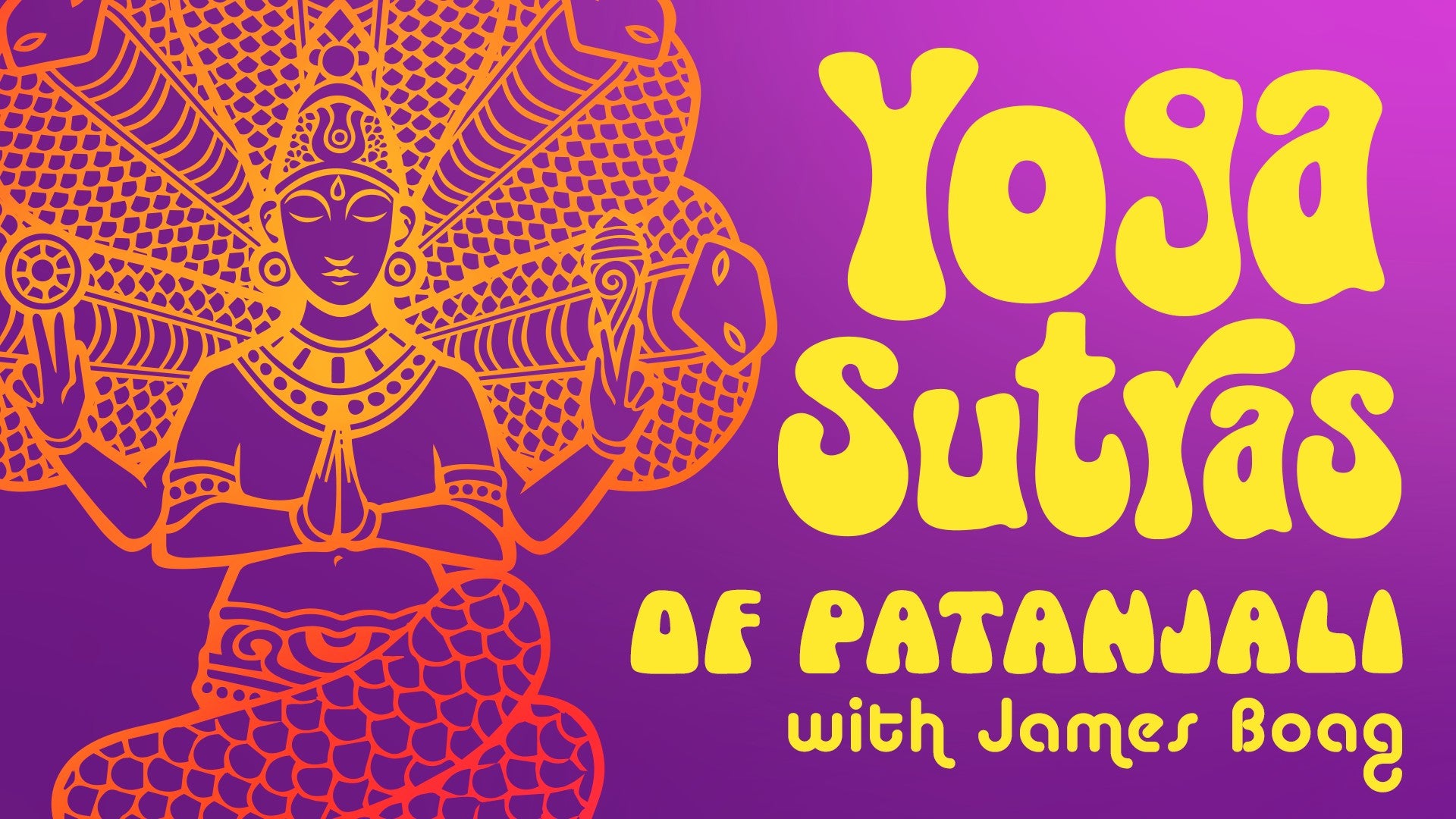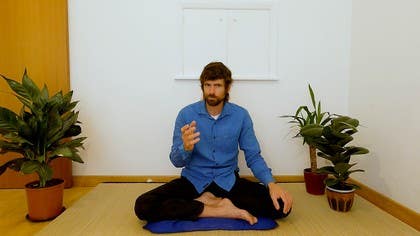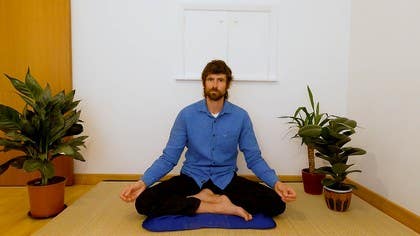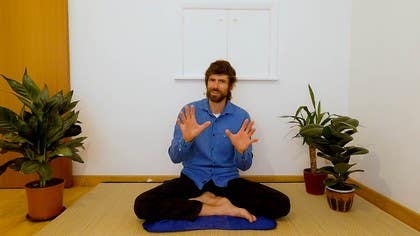Description
Sutra 2.30, ahimsa satya asteya brahmacharya aparigraha yama, goes into more depth about the first of the 8 limbs, the 5 Yamas. The Yamas are: ahimsa (non-harming), satya (truthfulness), asteya (non-stealing), brahmacharya (walking the path of godliness), and aparigraha (non-grasping). James points out that all 5 Yamas are for the sake of ahimsa, non-harming. In addition, the Yamas are not things we don't do, rather they are things we actively do, which encourage us to thoughtfully harness our energy, behave with respect toward all beings, and ultimately cultivate a state of wholeness.
Please see attached .PDF to follow along with James.
About This Video
Transcript
Read Full Transcript
So we've mentioned in sutra 29, the Ashtanga, the quite famous 8 limbs of classical, potentially in or Raja yoga, the yoga that leads us to becoming a sovereign, to becoming the established The person is established in true recognition of one's essential conscious nature. Now having introduced the eight limbs, potentially lists or starts to delineate what those limbs are. Annie starts with first in the list, the yammer. So Tatra Hinsa, Satya stay, Abramacharya, Parigraha, Yamma. So he tells us what the yamas are. So I'd like to show on the screen now a visual, which kind of outlines the 8 limbs and the yamas and the neyamas. We may refer to this a few other times as we continue, and it's, I hope, it'll be a nice resource for you to refer to at your leisure. So we have there the eight limbs with an English rendering of how we might describe them Of course, we could describe them in much greater length, and then we have the llamas laid out. So we'll, we'll refer to this a little bit more in just a moment, but Briefly recapping the 8 limbs, I mentioned that Yamani Yama are behavioral principles to harness our energy.
Now, sometimes people describe the yamers as restraints. But I've I prefer to think of them as means to harness or channel our energy. Sometimes acting in accord with Yama and Niyama will mean restraining ourselves, but I feel that Yama and Niyama mean more than just restraint or observance. So sometimes people describe Yamas as restraints and Neehamas as observances. But I think they're much broader than that. They do mean observing things, observing principles, cultivating principles, and sometimes they involve restraint. But I think it's really crucial to recognize that the Yamas are positive things. They're things that we do, potentially doesn't deal in don't.
Not only is he a master linguist, but Potanjali is the real deal Yogen? He's a master psychologist, and he had the insight. And he understood millennia ago that human beings don't really thrive or learn in the optimally efficient way with negative instruction. For example, if we hear something like, think of anything you like now, but do not think of a red Ferrari Who can keep the image of the red headed sports vehicle from their mind? It's very hard. Yeah.
Think of anything you like, but don't think of a pink elephant. And what happens? The pink elephant flows into our awareness. Similarly, I don't know about you, but sometimes, you know, and we see this all over it where people say, I don't do that. You know, some the forbidden fruit is very tempting. Potentially is always very affirmative, very encouraging. Very empowering.
And the yammer's, as we'll see with the next sutra, which is an extraordinary sutra, The Yamas are things that we need to do all the time. So what are these 5 Yamas? So perhaps we can bring the visual back up again. And we can see these 5 yamas. So we have uhinsa, satya, pastya, brahmacharya, and Now, we will go into these in more detail because Botania's gonna go on to talk about what's the benefit of really cultivating these principles in a little while.
But very briefly, himssa, it's really important to highlight this now as we'll see as we go on. There's the idea that all five yammers are for the sake of Ahintza. Because if we can become established in Ahintza, then we'll become established in New York. So does the idea that if we really work with them, they will deepen our establishment in a Hinsa, and the more established in Hinsa, the more it will be established in yoga. So what is a Hinsa? It's so prime.
What does it mean? So hints as a verb means to harm. The prefix in Sanskrit stands for nuh which means many things in Sanskrit. It means not or no. So we can quite accurately translate uhimsa as non harming. However, This, in Sanskrit, the prefix, which stands for nam, doesn't just mean not.
It also means other than different from, less than similar, but not quite like that. It has all these shades of meaning. And very, very importantly, the Sanskrit word, Ahinssa, is not a negative don't or no or not word. It is a positive principle. It's something we can actually do.
We can actually practice And that's why I prefer to think of a Hinsa first as an active positive principle of cultivating harmony. And only second as non harming, non violence, and all the rest of it. That is certainly an important part of Hinsa. Do no harm, for sure. But this isn't just something we avoid.
This is something we practice. We cultivate. So I think of it in a more active, positive sense. Of cultivating harmony. Satya. Satya also tremendously important in the yogic methods.
Satya means truthfulness. But such is from the verb root us, the verb to be. So such means beingness. So such, it doesn't just mean telling the truth, being honest, being authentic. It also means being present. And again and again, we see the primacy, the foundational importance of presence in the yogic method.
A stare. So we have the prefix, again. And so we commonly encounter the translation of non stealing, which is not inaccurate, but again, I would say it's not quite complete because this is an of principle. So I think of it as respectfulness. If I'm gonna be respectful to myself or to somebody else or to some other entity, I'm not gonna steal from it. So avoiding criminality of all shades, being respectful to myself and to all of life. This is Asteya.
Bramacharya. Now, Bramhan means totality char means to move to walk. So one time I was giving a a class on the eight limbs in mice were actually in India. And a gentleman came, and he gave a wonderful life. It was a wonderful rendering of this word.
Is it walking in the path of godliness? Is a lovely way of describing from Machariam. Behaving in ways that orient our energy towards that experience of totality. Also, Bahraman is the container in which all of the creation exists. So it also connotes our creative power.
It means being very respectful of our creative energy. Working to affortify and consolidate that energy rather than fritter it away. Now, we'll speak a little bit more about Well, let's speak about it now. Sometimes people talk about what I'm gonna charge you as continents or chastity. And I think though I quite like those 2 renderings, sometimes people talk about a celibacy. And it's an important point to mention that potentially is not anti human.
He's about to tell us in the next sutra that the Yamers are something we do all the time in all situations. The reason people sometimes describe or translate, but I'm a charity and celibacy in my opinion is because Soundscript words in different contexts have different meanings, but I'm with. We've mentioned it's walking the path of godliness learning to behave and channel our energy in ways that it moves towards cohesion, harmony, balance that it supports an experience of wholeness and totality. Now in the traditional Indian let's say, delineation or division of the stages of life. There are 4 stages of life. 1st stage is called Guess what? Brahmacharya. And this is the stage of studentship when one is learning how to chara how to walk, how to move, how to operate, how to function in the world, and that stage of life is called, And one's principle duty during that stage of life is student ship, being a student The next stage is Grihasta being a householder, which means producing children, furthering the society, working actively for the good of the whole wider community.
And then there's the idea once one has grandchildren, then one moved to the One so one moved to the outskirts of the town. You're no longer so fully in the thick of it, but you are very much still involved in societal community life, but as a respected elder, you're not so active. You're not holding the whole thing up. You are there as a support, a wise counselor, you're still active, but you've got that more, let's say, consult role. That supportive role. You're not doing you're not the the grihasters.
They're really holding up the whole family unit and all the active work of society. And then once your grandchildren moved to adulthood, does the edit you've Donald you need to do in society, Sun Yassin. Now, you can leave all the world concerns behind, go to the forest, and focus only on preparing to check out, to become free, to become liberated. You've done your duty, You've left the society in better shape than you found it, and now you can concentrate on liberation. And the idea is that, that first stage of life has set you up for those ensuing 3 stages. Including the last stage, but everything for everything a season, everything in due course.
There's the idea that as you navigate the challenges and responsibilities of being a householder. It will teach you about yourself, especially if you are making the effort to live in Dartmouth, in a balanced way, in a yogic way. But in that context of these 4 stages of life, when one is a student and one's responsibilities, not to work, but to study, to learn, to be an apprentice. Let's just imagine for a moment. There we are, and let's say we are fourteen years old.
And let's just say we are a flame for knowledge. We're really into whatever field of knowledge we're exploring. We're loving our studies. I'll give, I'm a I'm a man, and I'm a heterosexual man. So I'll give example of there I am, and I'm a flame for, let's say I'm a flame for god.
I'm studying spiritual things, and I'm really into it. And then she comes along. What might happen to the order of my flame for studies if she becomes the focus of my fire. Well, There is all there's this distinct possibility, but a lot of my creative energy and a lot of my intelligent power will be diverted towards that intoxicating realm of sexual intimacy, which for a young person can be very, very powerful. So the idea in the Indian system and the traditional setup is that during that Brahmacharya stage of life, one is celibate.
And one learns enough about how to interact with oneself and others that by the time one then moves into the Greychester stage and that whole realm of energetic exchange opens up. 1 is then prepared to navigate it skillfully harnessing the nourishing creative potential of that type of interaction. Once one has accrued a sufficient degree of maturity and mastery or expertise of various ways of being in the world so as not to get handicapped by never having really developed the foundations that can help us contribute positively to the wider society. I hope that's clear. The eyes in that context of Brammer cherry being the 1st stage of life, celibacy is a strong connotation of Ramacharya. It's not the denotation.
But it's a very strong connotation. And sometimes people have applied that very strong connotation of the Brahmacharya stage of life to Brahmacharya as it is mentioned here in a different context as a yammer. That is not to say that celibacy or Continents or chastity is not emphasizes being of tremendous importance for yoga. There is the idea that the sexual energy is very, very potent. Yoga is about transforming ourselves. It's about recreating ourselves. So the idea is that that energy that is so potent we want to harness it skillfully.
And some teachers say for people who are in a married situation, then they learn to deploy that energy for the sake of consolidating the practice for the sake of deepening one's establishment in yoga collaborating with one's partner for a monk or a nun or a nunceant, It's the idea that one will do all that internally, and one will circulate that energy within one's own system. But it's certainly the case that in the yogic method, it's very practical. It recognizes sexual energy is potent, and if one and it is it is also sacred. It is the source of life. So it has that tremendous recreational capacity.
It needs to be attended to with tremendous respect. Another term that can have, very strong cognitive associations. It literally means non grasping. However, whenever I teach this live, I always ask, I don't know your name, but I would say your name. Would you like to drink deep from the cup of life?
I hope the answer is yes. If we're gonna drink deep from the cup of life, how do we need to hold the dream drinking vessel? We need to grab it. We need to hold it with a certain grip but not too tight. If I grip the cup too tightly, that excess tension means I don't really enjoy it sweet and the sweeteners of the drink.
I might even crush the vessel and spill it everywhere. So I think of aparigraha as being present and grasping the cup of life, grasping the opportunity of each unfolding moment, but not too tightly. Loosening our grip, especially in the sense of loosening our expectations of how things need to can we find the depth of presence to show up, ready to experience the unfolding miracle of this new moment, however it's gonna be. A Peregra also has that con the connotation, very strong connotation, of non covetousness, not grasping things we don't need, not running after things that don't service. So in my own life, and in modern life in general, we can see that there's a lot of encouragement to chase things that we don't really need.
And yoga says, be very careful about what you run after. Be very careful about your energy. This human life is such a precious gift. But we only have so many breaths. We only have so many days, and we don't know how many more we have.
So as long as the energy of life is flowing on pulsating within me, may I use it respectfully so I can actually maximize its opportunity to help carry me more into that experience of yoga. More into that experience that's gonna bring me to that state of wholeness and deeper fulfillment. So the youngers, and the eight limbs as a whole, that's what they are aiming towards. All these members of the body of practice if we work with them, there's the idea that they can actually help bring us into that state of wholeness. So we'll speak more about the Yamas as we continue, hopefully, that gives a little bit of a overview or introduction.







You need to be a subscriber to post a comment.
Please Log In or Create an Account to start your free trial.